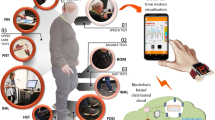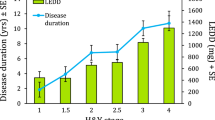Abstract
Neurological disorders of gait, balance and posture are both debilitating and common. Adequate recognition of these so-called disorders of axial mobility is important as they can offer useful clues to the underlying pathology in patients with an uncertain clinical diagnosis, such as those early in the course of neurological disorders. Medical teaching programmes typically take classic clinical presentations as the starting point and present students with a representative constellation of features that jointly characterize a particular axial motor syndrome. However, patients rarely present in this way to a physician in clinical practice. Particularly in the early stages of a disease, patients might display just one (or at best only a few) abnormal signs of gait, balance or posture. Importantly, these individual signs are never pathognomonic for any specific disorder but rather come with an associated differential diagnosis. In this Perspective, we offer a new diagnostic approach in which the presenting signs are taken as the starting point for a focused differential diagnosis and a tailored search into the underlying neurological syndrome.
This is a preview of subscription content, access via your institution
Access options
Access Nature and 54 other Nature Portfolio journals
Get Nature+, our best-value online-access subscription
$29.99 / 30 days
cancel any time
Subscribe to this journal
Receive 12 print issues and online access
$209.00 per year
only $17.42 per issue
Buy this article
- Purchase on Springer Link
- Instant access to full article PDF
Prices may be subject to local taxes which are calculated during checkout
Similar content being viewed by others
References
Wenning, G. K. et al. Progression of falls in postmortem-confirmed parkinsonian disorders. Mov. Disord. 14, 947–950 (1999).
Nutt, J. G. et al. Freezing of gait: moving forward on a mysterious clinical phenomenon. Lancet Neurol. 10, 734–744 (2011).
Nonnekes, J. et al. Freezing of gait: a practical approach to management. Lancet Neurol. 14, 768–778 (2015).
Speelman, A. D. et al. How might physical activity benefit patients with Parkinson disease? Nat. Rev. Neurol. 7, 528–534 (2011).
Scheffer, A. C., Schuurmans, M. J., van Dijk, N., Van Der Hooft, T. & De Rooij, S. E. Fear of falling: measurement strategy, prevalence, risk factors and consequences among older persons. Age Ageing 37, 19–24 (2008).
Mak, M. K. & Pang, M. Y. Fear of falling is independently associated with recurrent falls in patients with Parkinson's disease: a 1-year prospective study. J. Neurol. 256, 1689–1695 (2009).
Mahlknecht, P. et al. Prevalence and burden of gait disorders in elderly men and women aged 60–97 years: a population-based study. PLoS ONE 8, e69627 (2013).
Lees, A. J. When did Ray Kennedy's Parkinson's disease begin? Mov. Disord. 7, 110–116 (1992).
Nurnberger, L. et al. Ultrasound-based motion analysis demonstrates bilateral arm hypokinesia during gait in heterozygous PINK1 mutation carriers. Mov. Disord. 30, 386–392 (2015).
Araujo, R., Ferreira, J. J., Antonini, A. & Bloem, B. R. “Gunslinger's gait”: a new cause of unilaterally reduced arm swing. BMJ 351, h6141 (2015).
Mirelman, A. et al. Gait alterations in healthy carriers of the LRRK2 G2019S mutation. Ann. Neurol. 69, 193–197 (2011).
Bloem, B. R. et al. Idiopathic senile gait disorders are signs of subclinical disease. J. Am. Geriatr. Soc. 48, 1098–1101 (2000).
Jacobi, H. et al. Spinocerebellar ataxia types 1, 2, 3 and 6: the clinical spectrum of ataxia and morphometric brainstem and cerebellar findings. Cerebellum 11, 155–166 (2012).
Litvan, I. et al. Clinical research criteria for the diagnosis of progressive supranuclear palsy (Steele–Richardson–Olszewski syndrome): report of the NINDS-SPSP International Workshop. Neurology 47, 1–9 (1996).
Wenning, G. K., Benshlomo, Y., Magalhaes, M., Daniel, S. E. & Quinn, N. P. Clinical features and natural history of multiple system atrophy. An analysis of 100 cases. Brain 117, 835–845 (1994).
Wenning, G. K. et al. The natural history of multiple system atrophy: a prospective European cohort study. Lancet Neurol. 12, 264–274 (2013).
Doherty, K. M. et al. Postural deformities in Parkinson's disease. Lancet Neurol. 10, 538–549 (2011).
Hoskovcova, M. et al. Disorders of balance and gait in essential tremor are associated with midline tremor and age. Cerebellum 12, 27–34 (2013).
Stolze, H., Petersen, G., Raethjen, J., Wenzelburger, R. & Deuschl, G. The gait disorder of advanced essential tremor. Brain 124, 2278–2286 (2001).
Baik, J. S. & Lang, A. E. Gait abnormalities in psychogenic movement disorders. Mov. Disord. 22, 395–399 (2007).
Stone, J. Functional neurological symptoms. J. R. Coll. Physicians Edinb. 41, 38–41 (2011).
Edwards, M. J. & Bhatia, K. P. Functional (psychogenic) movement disorders: merging mind and brain. Lancet Neurol. 11, 250–260 (2012).
Lawrence, D. G. & Kuypers, H. G. The functional organization of the motor system in the monkey. I. The effects of bilateral pyramidal lesions. Brain 91, 1–14 (1968).
Nutt, J. G., Marsden, C. D. & Thompson, P. D. Human walking and higher-level gait disorders, particularly in the elderly. Neurology 43, 268–279 (1993).
Snijders, A. H., van de Warrenburg, B. P., Giladi, N. & Bloem, B. R. Neurological gait disorders in elderly people: clinical approach and classification. Lancet Neurol. 6, 63–74 (2007).
Fasano, A. & Bloem, B. R. Gait disorders. Continuum 19, 1344–1382 (2013).
Bodranghien, F. et al. Consensus paper: revisiting the symptoms and signs of cerebellar syndrome. Cerebellum 15, 369–391 (2016).
Abdo, W. F. et al. Ten steps to identify atypical parkinsonism. J. Neurol. Neurosurg. Psychiatry 77, 1367–1369 (2006).
Charlett, A., Weller, C., Purkiss, A. G. & Dobbs, S. M. Breadth of base whilst walking: effect of ageing and parkinsonism. Age Ageing 27, 49–54 (1998).
Pistacchi, M. et al. Gait analysis and clinical correlations in early Parkinson's disease. Funct. Neurol. 32, 28–34 (2017).
Hass, C. J. et al. Quantitative normative gait data in a large cohort of ambulatory persons with Parkinson's disease. PLOS ONE 7, e42337 (2012).
Nanhoe-Mahabier, W. et al. Parkinson disease and comorbid cerebrovascular disease. Nat. Rev. Neurol. 5, 533–541 (2009).
Carpenter, M. G., Allum, J. H., Honegger, F., Adkin, A. L. & Bloem, B. R. Postural abnormalities to multidirectional stance perturbations in Parkinson's disease. J. Neurol. Neurosurg. Psychiatry 75, 1245–1254 (2004).
Burleigh-Jacobs, A., Horak, F. B., Nutt, J. G. & Obeso, J. A. Step initiation in Parkinson's disease: influence of levodopa and external sensory triggers. Mov. Disord. 12, 206–215 (1997).
Rocchi, L. et al. Step initiation in Parkinson's disease: influence of initial stance conditions. Neurosci. Lett. 406, 128–132 (2006).
Aerts, M. B., Abdo, W. F. & Bloem, B. R. The “bicycle sign” for atypical parkinsonism. Lancet 377, 125–126 (2011).
Salinas, S., Proukakis, C., Crosby, A. & Warner, T. T. Hereditary spastic paraplegia: clinical features and pathogenetic mechanisms. Lancet Neurol. 7, 1127–1138 (2008).
Nonnekes, J., van Lith, B., van de Warrenburg, B. P., Weerdesteyn, V. & Geurts, A. C. H. Pathophysiology, diagnostic work-up and management of balance impairments and falls in patients with hereditary spastic paraplegia. J. Rehabil. Med. 49, 369–377 (2017).
Nutt, J. G. Higher-level gait disorders: an open frontier. Mov. Disord. 28, 1560–1565 (2013).
Yamamoto, T., Takiguchi, N., Tamura, N., Iwasaki, S. & Araki, N. An unusual focal leg dystonia in descending stairs responsive to anticonvulsants. Clin. Neurol. Neurosurg. 114, 60–62 (2012).
Author information
Authors and Affiliations
Contributions
J.N. and B.R.B. wrote the manuscript. All authors contributed substantially to discussions of the article content and to the review or editing of the article before submission.
Corresponding author
Ethics declarations
Competing interests
The authors declare no competing financial interests.
Supplementary information
Supplementary video S1
Extreme broad-based gait in a man with spinocerebellar ataxia type 2. The authors affirm that the human research participant provided informed consent for publication of the images in Supplementary information (video) S1. (MP4 23934 kb)
Supplementary video S2
Variable base of support in spinocerebellar ataxia. Variable base of support (including a broadened stance width) in a man with spinocerebellar ataxia type 3, with a clear widening of the base of support during turning. The authors affirm that the human research participant provided informed consent for publication of the images in Supplementary information (video) S2. (MP4 18216 kb)
Supplementary video S3
Broad-based gait in sensory ataxia. Moderate broad-based gait in a woman with sensory ataxia due to diabetic neuropathy. The authors affirm that the human research participant provided informed consent for publication of the images in Supplementary information (video) S3. (MP4 10086 kb)
Supplementary video S4a
Effects of treatment on gait abnormalities. a | Broad-based gait in a man with normal-pressure hydrocephalus. The authors affirm that the human research participant provided informed consent for publication of the images in Supplementary information (video) S4a. (MP4 2822 kb)
Supplementary video S4b
Effects of treatment on gait abnormalities. b | A reduction in the width of the broadened base of support is evident after a spinal tap procedure that removed 35 ml of fluid. In this patient, instrumented gait analysis was used to quantify the effects of this intervention. The authors affirm that the human research participant provided informed consent for publication of the images in Supplementary information (video) S4b. (MP4 2353 kb)
Supplementary video S5
Narrow-based gait in Parkinson disease. Narrow-based gait in a man with idiopathic Parkinson disease. During long-standing disease (onset of symptoms 11 years ago), his gait has remained narrow-based. The authors affirm that the human research participant provided informed consent for publication of the images in Supplementary information (video) S5. (MP4 20203 kb)
Supplementary video S6
Narrow-based gait in spastic paraplegia. Narrow-based gait in a man with hereditary spastic paraplegia. The authors affirm that the human research participant provided informed consent for publication of the images in Supplementary information (video) S6. (MP4 25384 kb)
Supplementary video S7
Gait-scissoring in a functional gait disorder. Gait-scissoring in a woman with a functional gait disorder. This video comes from the collection of Prof Arthur van Gehuchten, a Belgian anatomist (1861–1914). (MP4 34490 kb)
Supplementary video S8
Gait-scissoring in chorea. Gait-scissoring in a woman with Huntington chorea, alternating with a compensatory wide-based and almost ataxic gait. Associated involuntary choreatic movements can also be seen in the limbs. The authors affirm that the human research participant provided informed consent for publication of the images in Supplementary information (video) S8. (MP4 44919 kb)
Rights and permissions
About this article
Cite this article
Nonnekes, J., Goselink, R., Růžička, E. et al. Neurological disorders of gait, balance and posture: a sign-based approach. Nat Rev Neurol 14, 183–189 (2018). https://doi.org/10.1038/nrneurol.2017.178
Published:
Issue Date:
DOI: https://doi.org/10.1038/nrneurol.2017.178
This article is cited by
-
Imbalance and gait impairment in Parkinson’s disease: discussing postural instability and ataxia
Neurological Sciences (2024)
-
Context expectation influences the gait pattern biomechanics
Scientific Reports (2023)
-
Validity, reliability and minimal detectable change of Mini-BESTest Turkish version in neurological disorders
Acta Neurologica Belgica (2023)
-
Prognostic relevance of gait-related cognitive functions for dementia conversion in amnestic mild cognitive impairment
BMC Geriatrics (2023)
-
Instrumented gait analysis defines the walking signature of CACNA1A disorders
Journal of Neurology (2022)



